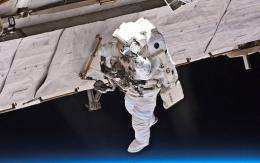July 21, 2015 weblog
Astronauts' skin changes before and after missions are studied

As NASA once put, space is no trip to the spa. Changes in skin occur during spaceflight. According to recent reports, scientists have found that skin of astronauts who spend a lot of time in space gets thinner.
The team of researchers went looking for answers, said David Moceri on Tuesday in Capital Wired. Over the years, he said, it was observed that many astronauts suffered skin problems. What happens to human skin during a journey to space?
Both the European Space Agency and NASA asked a team from the Department of Biophotonics and Laser Technology at Saarland University for more information.
Three astronauts were examined before and after their space journey. Reactions of skin structure to a mission were imaged using advanced imaging technology. Moceri said, "According to them, this imaging technology is similar to a real tissue biopsy, providing detailed information that helps the researchers learn more about the skin layers after spending time in space."
Findings: The morphology of the skin suffers changes during space travel. First off, skin produced a higher level of collagen in space. Second, the epidermis was shrinking, especially in the region of living cells. "The scientists said that the epidermis got thinner by almost 20 percent than it usually is," said Moceri.
Discussing the technology at play in this investigation, Professor Karsten Koenig from the Department of Biophotonics and Laser Technology at Saarland University said in a Monday Reuters report that "We use femtosecond laser pulses. We scan the skin and we get signals from the skin, particularly fluorescence, as well as another signal called second harmonic generation. So with these two signals we can build up images and get a precise look into the skin with a high resolution." Koening said the resolution was a factor of one thousand (times) better than ultrasound.
The technique means researchers can get the information in seconds that would otherwise need to come from taking biopsies, slicing them, staining them, and having a pathologist study them,
Nonetheless, there is more research to be done. Scientists have been made aware what happens but they still search for more information.
"So far we have no explanation yet, and we are waiting for the other astronauts to figure out what's going on and maybe to try to figure out how we can protect, how we can help so that this epidermis is not shrinking," said Koenig in the Reuters report.
Koenig and his team will continue looking into what causes the thinning of astronauts' skin - and more crucially, how it can be prevented, said Reuters. "We've seen the epidermis get thinner by nearly 20 percent. And so far we have no explanation."
© 2015 Phys.org. All rights reserved.




















